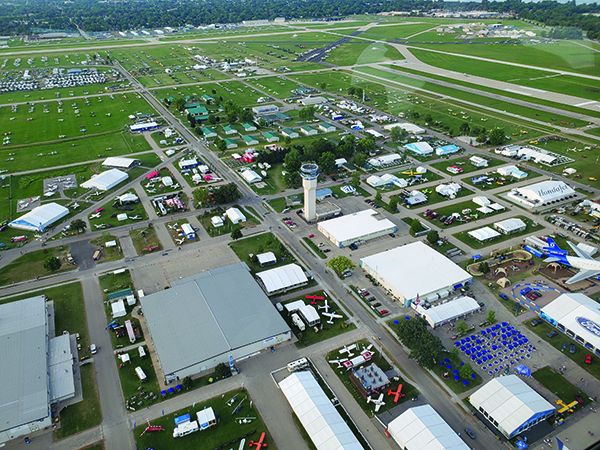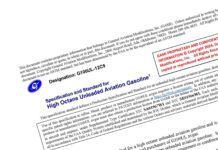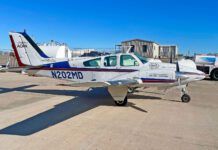Having skipped a year due to pandemic shutdowns in 2020, AirVenture came galloping back in 2021, with near-record attendance, more aircraft than ever on the field and, most impressive, strong sales for aircraft companies and vendors. EAA Chairman Jack Pelton said the showing was all the more impressive because as late as December 2020, with COVID-19 restrictions still in place, it wasn’t apparent that the show would happen at all.
As AirVentures go, 2021 was average for product intros and innovation. Much of what we saw we either knew was coming or fell within the normal ebb of flow of new stuff companies seem to hold until the gates at Witt-man field open. One unexpected surprise—and probably the most significant announcement—was a long-awaited approval for an unleaded 100-octane fuel to finally replace 100LL. More on that later.
As of early August, EAA estimated that 608,000 people passed through the gates, marking the third time that attendance has exceeded 600,000. That was within 5 percent of 2019’s record attendance and if international travel hadn’t been curtailed by pandemic restrictions, 2021 might have been a record year, too. The number of aircraft flown into Wittman by Monday was 7920, more than double the 2019 weather- diminished tally.
G100 (FINALLY)
Although we knew it was coming a couple of weeks before the show, the surprise major development was the FAA’s awarding of a limited STC for General Aviation Modifications Inc.’s G100 unleaded fuel. After more than a decade of research and testing, G100 represents the first 100-octane unleaded aviation fuel that appears to be a direct drop-in.
GAMI has been sparring with the FAA bureaucracy since it proposed in 2009 approving a new fuel through an STC/AML process. The agency dragged its feet on approving GAMI’s test programs while the agency ground through the abortive Piston Aviation Fuels Initiative that was supposed to result in an approvable fuel by 2018. As far as we know, PAFI is moribund and it looks like G100 has the inside track for eventual wide distribution. Avfuel, which distributes about 40 percent of aviation fuel in the U.S., has agreed to partner with GAMI to manufacture and distribute G100.
As we’ve reported previously, G100 is a blended fuel consisting of a high-octane base alkylate blended with a proprietary aromatic octane package. Although it’s chemically different than 100LL, it has the equivalent or higher octane and has been sufficiently tested to serve as a drop-in replacement, including mixing the fuels in any ratios. It weighs 6.2 pounds per gallon compared to 6 pounds for 100LL.
The initial STCs will cover Lycoming four-cylinder engines in Cessna 172s, both fuel-injected and carbureted. The STC will be expanded with some additional testing later in 2021 and 2022 to eventually include the entire fleet. Avfuel’s Craig Sincock told Aviation Consumer that manufacturing and distribution timing is indeterminate. “I was kidding around this morning and said on October 1, I’d be ready to go. I didn’t say which year,” Sincock told us.
GAMI’s George Braly said G100 would cost between 60 and 85 cents more per gallon than 100LL does now. This price delta appears to have already thrown a snag into initial fielding of the fuel. Embry-Riddle Aeronautical University had tentatively agreed to use G100 for its fleet, but has now declined to do so because it doesn’t want to pass the additional cost on to students. Sincock said the price would come down as more distribution points are developed. Meanwhile, GAMI says other launch customers are interested.
In addition to GAMI’s announcement, Swift Fuels announced that it is expanding distribution of its UL94 fuel in California. Swift broke into the market at San Carlos in 2016 and now says it will expand to 25 airports in northern California and 22 in the southern part of the state. UL94 is manufactured for Swift by contract refineries.
Like GAMI, Swift has been developing its own 100-octane fuel and although it was included in the PAFI program, it has since withdrawn from it. Swift’s UL94 is currently available at 23 public-use airports, most in the Midwest.
NEW AIRCRAFT
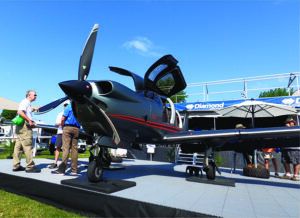
As expected, Diamond attracted some eyeballs to its new DA50 RG, which appeared at Oshkosh and in the U.S. for the first time. Although we have seen the airplane before, specifically at Aero in 2019, the version at AirVenture was a full-up production model resplendent in carbon-fiber gray. If there were any surprises for people looking at it, it’s the sheer size. The DA50 has the same cabin as the DA62 twin, but has shorter wings. The systems are similar to the twin as well.
And, surprisingly, the price difference compared to the twin is essentially the cost of the additional engine. Price for the North American market will be $1.3 million with typical equipment and most buyers get the airplanes fully optioned. Diamond may have a challenge selling against Cirrus, since that price is above the just-under-a-million sticker on the SR22T for an airplane with less useful load and lower speed.
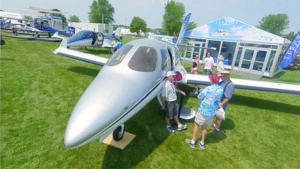
The DA50 has a new engine for Diamond, the Continental CD-300, a V-6 adapted from a Mercedes automotive engine. Diamond has already sold one of the airplanes and will be touring the model through North America during the fall.
While Icon, with its sporty A5, has been retrenching and retooling, they announced at AirVenture plans to certify the airplane in the primary category. Icon’s Warren Curry said the company believes there’s foreign sales potential for the A5, but a patchwork of variable light sport and ultralight regulations has made closing the deals difficult. The company has upgraded the airplane with a new appearance package and the previously announced Garmin G3X package.
But the A5 remains at the top of the LSA price tier. The G3X model will sell for $399,000 in the primary category version, $384,000 in the LSA version and the LSA model equipped with the aera 796 will retail for $359,000.
Kit aircraft get ever more ambitious and at AirVenture, Stratos upped the ante with the new 716X single-engine jet. The idea is to sell a dozen to prove the design and production systems, then move to a certified version. It’s a six-seater powered by a Pratt & Whitney JT15D-5 engine rated at 2950 pounds thrust. Price: $2.5 for the kit; add another mil for the certified version.
While Diamond has done we’ll with a line of aircraft predominantly powered by Jet-A piston engines, Tecnam evidently sees an opening for those engines, too. A year ago, Tecnam announced the P2010 TDI, a diesel version of the Lycoming-powered P2010 it first certified in 2015. You may recall this airplane is similar to the Cessna 172, but with a third entry door for the backseat. At Oshkosh, with an expanded display presence, they announced the airplane will be available for the North American market powered by the Continental CD-170. The company also announced a new upgrade to the P92 Echo, increasing its useful load to 610 pounds.
ELECTRICS FLY
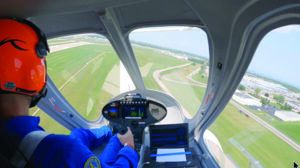
In previous years, we’ve seen a smattering of electric airplanes at AirVenture but these projects can best be described as aspirational. And we’re thinking here about the multi-rotor offerings, not the conventional fixed-wing such as the Pipistrel Alpha Electro that has been flying in demonstration mode in the U.S. for two years.
But this year, two did fly, Opener’s quirky BlackFly multi-rotor and Volocopter’s unique take on the helicopter. To be sure, they didn’t fly for long, but at least crowds got to see what they look—and sound—like. The BlackFly is nothing more or less than a large drone capable of carrying a 200-pound person. The company’s Marcus Leng declined to say what the endurance is, but said the range was about 25 miles.
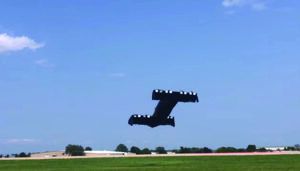
The company says it’s in full-up production and ready to start selling these things. They have been cagey about the price, adhering to the anodyne claim that the BlackFly will cost about as much as an SUV. But is that a $90,000 Range Rover or a $25,000 Nissan Rogue? Leng won’t say. But we do know the BlackFly has no pretensions about being practical transportation. It’s an ultralight toy that doesn’t require pilot certification and can’t be flown over congested areas or at night. It is equipped with a ballistic parachute. With eight motors and props, the BlackFly’s noise signature emulates the bug for which it’s named: a persistent buzz. It’s not overwhelmingly loud, but it’s not unnoticeable, either. (See a video at our sister publication, www.avweb.com.)
An aircraft that does have transportation ambition is the Volocopter, which also flew in an airshow demo at Oshkosh. This aircraft has 18 rotors arrayed in a circular boom design and is now into its second iteration called the Volo City. It’s meant to be a single-passenger air taxi inside city confines. It was on display at AirVenture, but the version that flew was the earlier model. Volocopter’s Florian Reuter said the project is on track to enter limited commercial service by the 2024 Olympics.
Honorable mention to the Bye Aerospace eFlyer. The company was there, but not the airplane. The latest version of it has been in flight test and the company’s owner, George Bye, said it will be certified to Part 23 primary category status sometime in 2023. Target price is $489,000.
AVIONICS/ GADGETS
The two major avionics announcements were Garmin’s Smart Glide and the Vantage aftermarket EFIS system for legacy Cirrus airplanes from Avidyne. We reported on both in the September 2021 issue of Aviation Consumer. Shrewdly, Garmin attracted staggering traffic around its expanded outside booth, thanks to parking Mike Patey’s Scrappy STOL plane alongside Steve Thorne’s upscale, Garmin-equipped RV-14.
Late in the show, Avidyne announced a tantalizing new product: an AI-based second set of eyes called PilotEye Vision. It’s a multi-source architecture that scans for traffic, airborne hazards, weather and other threats to flight safety, all the while scouring the countryside for emergency landing sites. Avidyne is pairing with Daedalean to bring this product to market at an as-yet undisclosed price.
During the pandemic, ForeFlight has been quiet about upgrades, but they’ve been going on nonetheless. At AirVenture, they showed off a couple of stunners, including new 3D mapping of real-time weather and something called Dynamic Wind Advisor that throws impressive graphics and processing power at what old heads used to call pressure navigation. It’s the best visual presentation of winds we’ve seen.
In the training segment, Redbird announced an app-based product called Redbird Pro that offers a sort of ongoing progressive training program that sharpens skills through specific tasks. It’s centered on simulator work, but can also be done in an aircraft. It will be available later in the year on a subscription basis.
King Schools introduced a new Part 121 airline ops course for newly hired pilots who want familiarization on topics like dispatch, ops specs and all the regulatory stuff airline pilots have to live with. It also announced a Flashcard app that works with any of its courses for last-minute brush-up before a written.
BIG SALES
If companies were concerned about turnout and sales, those fears evaporated on the first day of the show. Vendor hangars were packed and even the outside venues were crowded. CubCrafters told us it had a record year, selling 34 aircraft during the week, exactly doubling the 2019 numbers. That will keep the factory busy right through 2022, said the company’s Chip Allen. Most if not all of those buyers weren’t the repeat customers CC usually attracts, but new customers who plunked down $67,000 nonrefundable deposits on X or NXCubs.
Other companies such as Bose and Aircraft Spruce & Specialty also reported heavy traffic and record sales, despite the slightly smaller crowds over 2019.

